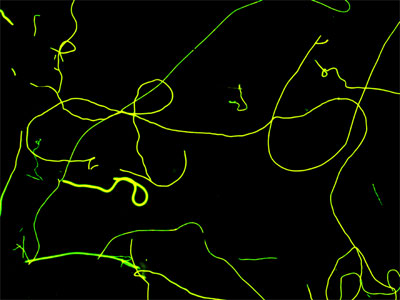| Posted: Jan 31, 2008 | |
Smart nanofibers at the flip of a light switch |
|
| (Nanowerk Spotlight) 'Smart' is the key buzz word used by materials engineers when they describe the future of coatings, textiles, building structures, vehicles and just any material that you can think of. Materials are made 'smart' when they are engineered to have properties that change in a controlled manner under the influence of external stimuli such as mechanical stress, temperature, humidity, electric charge, magnetic fields etc. Nature of course is full with 'smart' materials that are capable of adapting to new tasks, are self-healing, and can self-assemble autonomously simply out of a solution of building blocks. Duplicating this feat with man-made materials will one day become a reality thanks to nanotechnology. | |
| Scientists not only dream about self-repairing cars or building walls that turn transparent like windows, they are actively working on the first steps towards these goals. Simple smart materials (that are not nanotechnology based) are already a reality, such as piezoelectric materials and shape memory alloys. Emerging nanotechnologies are now about to give scientists the tools to take smart materials to the next performance level. For instance, the European project Inteltex is developing a new, multifunctional textile that could be used as a wallpaper to detect temperature changes or chemical leakage or that could be used in medical and protective wear to monitor body temperature and mechanical stress. | |
| MIT's Institute for Soldier Nanotechnologies works on smart surfaces that switch properties (watch a video here). Nanotechnology-enabled smart materials are still very early days but basic progress is being made. Another small building block towards smart materials was recently reported by Italian researchers who demonstrated photo-switchable nanofibers based on the reversible transformation between two molecular photochemical states, exhibiting different chemico-physical characteristics. | |
| "Notwithstanding the remarkable advances of nanotechnology, photo-switchable nanomaterials have not been investigated in depth so far" Dario Pisignano tells Nanowerk. "Although photochromic nanostructures can be envisaged as nanoscale light sources, switches, detectors, sensors for integrated nanophotonics, and functional elements for nanoactuation and smart surfaces, to date photo-switchable nanomaterials are basically unexplored." | |
| Pisignano, a researcher at the National Nanotechnology Laboratory (NNL) at the Universita' degli Studi di Lecce in Italy, says this is surprising given that organic nanofibers can be easily manufactured, controlled with high precision, and photochromic molecules – or generally molecular dopants providing optical functionality – can be straightforwardly incorporated into the nanostructures. | |
 |
|
| Electrospun mixture of green and yellow luminescent nanofibers (Image: Dario Pisignano, NNL). | |
| The Italian researchers realized and characterized one of the first photo-switchable nanomaterials, an electrospun nanofiber. These fibers rely on embedding photochromic molecular systems, which are able to reversibly change their isomeric state upon irradiation with radiation of a certain wavelength. The nanofibers are embedded in a polymer matrix and the material can be processed by low-cost, high-throughput methods such as electrospinning. | |
| They reported their findings in a recent paper published in the December 20, 2007 online edition of Advanced Materials ("Photo-switchable Organic Nanofibers"). | |
| "We are particularly interested towards miniaturized light-emitting sources, especially aiming at the integration – in sensors, biodiagnostic and lab-on-chip devices – of entirely biocompatible, organic-based light sources" says Pisignano. "The good stability and cycling performances we saw open new possibilities for the realization of light-driven nanoscale elements to be incorporated not only in sensors and lab-on-chip devices but also optical interconnects. The nanofiber geometry can provide the enhanced control of smart surfaces and controlled device function down to the scale of tens of nanometers without the need for nanolithography." | |
| The NNL scientists have just begun exploring the intriguing properties of these light-emitting nanomaterials. Relevant areas of study will include the assembly of complex optical circuits based on active and passive nanofibers and their integration with biological chips for providing optoelectronic sensing functionality. | |
| In case you want to read up on the topic, we have written a number of Spotlights on early progress with nanotechnology-enabled smart materials: | |
| Light-controlled smart material exploits billions of years of evolutionary performance tuning of bacteria | |
| Nanotechnology material, heal thyself | |
| Unlocking nature's protein material concepts enables tomorrow's nanotechnology materials and cures | |
 By
Michael
Berger
– Michael is author of three books by the Royal Society of Chemistry:
Nano-Society: Pushing the Boundaries of Technology,
Nanotechnology: The Future is Tiny, and
Nanoengineering: The Skills and Tools Making Technology Invisible
Copyright ©
Nanowerk LLC
By
Michael
Berger
– Michael is author of three books by the Royal Society of Chemistry:
Nano-Society: Pushing the Boundaries of Technology,
Nanotechnology: The Future is Tiny, and
Nanoengineering: The Skills and Tools Making Technology Invisible
Copyright ©
Nanowerk LLC
|
|
|
Become a Spotlight guest author! Join our large and growing group of guest contributors. Have you just published a scientific paper or have other exciting developments to share with the nanotechnology community? Here is how to publish on nanowerk.com. |
|
